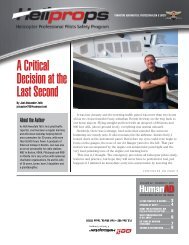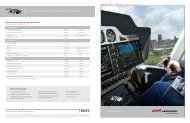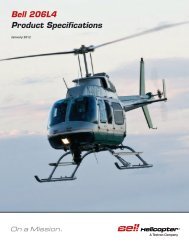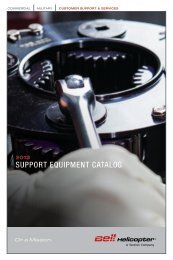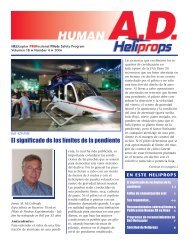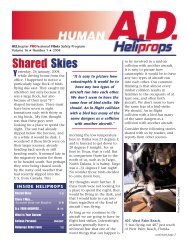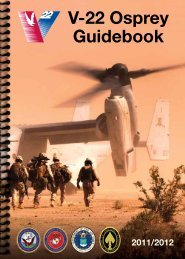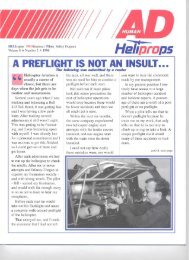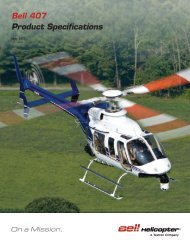Single Pilot Looking for CRM - Bell Helicopter
Single Pilot Looking for CRM - Bell Helicopter
Single Pilot Looking for CRM - Bell Helicopter
Create successful ePaper yourself
Turn your PDF publications into a flip-book with our unique Google optimized e-Paper software.
Telling It Like It Is continued<br />
helicopters. On numerous occasions<br />
these systems have been found to be lifesavers<br />
<strong>for</strong> crew and passengers. Failure to<br />
use them properly can prove to be fatal.<br />
NTSB Report NYC73AN072<br />
In this mishap the 11,164-hour, noninstrument<br />
rated pilot of a <strong>Bell</strong> 212<br />
departed a Pennsylvania airport during<br />
daylight and continued VFR flight in<br />
adverse weather conditions. Rain/snow,<br />
fog, low ceiling, sky obscured. The<br />
aircraft was flown into trees on obscured,<br />
rising terrain. As the pilot was not<br />
wearing the aircraft’s shoulder straps his<br />
chest struck the cyclic stick on impact.<br />
He survived the crash, and was able to<br />
get out of the cockpit, enter the cabin,<br />
and use the medical kit to bandage his<br />
wounds. But be<strong>for</strong>e the weather permitted<br />
searchers to locate him the next day, his<br />
injuries proved fatal. In this mishap the<br />
aircraft maintained a survivable cabin in<br />
the crash. But the pilot’s failure to use his<br />
shoulder straps did not allow the restraint<br />
system to do its job. This mishap occurred<br />
in November 1972. Back then there was a<br />
certain attitude amongst some pilots that<br />
shoulder straps were unnecessary and the<br />
straps would be a bother in the event a<br />
pilot wished to speedily exit the cockpit.<br />
There is current anecdotal data<br />
indicating some pilots and crewmembers<br />
– particularly EMS crewmembers –<br />
today choose not to use their shoulder<br />
straps. The rationale <strong>for</strong> failing to use<br />
the shoulder straps varies – com<strong>for</strong>t,<br />
efficiency, freedom of movement, etc.<br />
Seat belts and shoulder straps are like<br />
many other items of safety equipment.<br />
We see them, we touch them, we are<br />
aware of them; but these things are rarely<br />
called upon to per<strong>for</strong>m their duties.<br />
The examples abound. Life rafts are<br />
carried by many offshore operators, but<br />
only handfuls are ever inflated after a<br />
<strong>for</strong>ced water landing. Personal flotation<br />
devices (life jacket and the various<br />
6 VOLUME 19 #2 • HELIPROPS<br />
attached pieces of equipment) are worn<br />
by pilots <strong>for</strong> thousands of hours with few<br />
ever used in actual need. An Emergency<br />
Locator Transmitter (ELT) is installed on<br />
all helicopters; but few pilots check if it<br />
is armed or if it even functions. Survival<br />
gear gets flown over rugged cold country<br />
without ever being deployed. Helmet<br />
visors are routinely lowered but very few<br />
windshields are ever penetrated by a bird<br />
strike.<br />
This recognition “I know I use it, I have it,<br />
or it is there; but I have never needed it to<br />
per<strong>for</strong>m in all the years I have been flying<br />
helicopters” can lead to complacency<br />
and some silly methods of handling or<br />
ignoring this equipment.<br />
Personal flotation device. Because<br />
of the discom<strong>for</strong>t of its weight and fit,<br />
many a personal flotation device rides<br />
in the cabin while the com<strong>for</strong>table (and<br />
vulnerable) pilot sits in the cockpit.<br />
Helmet. Some pilots, who are provided<br />
with helmets, choose not to wear them<br />
because the helmets are hot, heavy, and<br />
uncom<strong>for</strong>table, don’t look good, and<br />
presumably scare the passengers.<br />
Flight Suit. Fashionable, smart-looking,<br />
fire retardant flight suits are provided<br />
by certain operators to their pilots and<br />
crews. The protection these flight suits<br />
can provide is diminished by those who<br />
roll up the sleeves <strong>for</strong> the neat look and<br />
feel.<br />
Wet Suit. Some offshore operators have<br />
their pilots (and <strong>for</strong> some operators,<br />
their passengers) wear a wet suit that<br />
would prevent or delay water immersion<br />
hypothermia in the event of a <strong>for</strong>ced<br />
landing. For some, the criterion <strong>for</strong> the use<br />
of a wet suit is a combination of the air and<br />
water temperature. If the sum of the two<br />
temperatures is less than a certain number,<br />
a wet suit is required. When spring arrives<br />
and the air temperature increases but the<br />
water temperature is still low, a wet suit<br />
may be required; but wearing one quickly<br />
makes a pilot awfully hot. Consequently,<br />
a knowing pilot will not wear the wet<br />
suit but store it somewhere in the cabin<br />
or baggage compartment where it would<br />
be practically inaccessible after a <strong>for</strong>ced<br />
water landing.<br />
The vast majorities of helicopter pilots<br />
go through their entire careers and never<br />
have an incident or accident – and that<br />
is good. But when that unwanted crash<br />
landing is about to happen, the wet suit in<br />
the baggage compartment, the personal<br />
flotation device in the cabin, the helmet<br />
in the locker room, and the shoulder<br />
straps behind your back are worthless.<br />
Ignoring the safety equipment provided<br />
to you is, pardon the word, stupid. Your<br />
life, and those of your passengers, may<br />
depend on it.<br />
While we are visiting this safety<br />
equipment topic here are a few other<br />
comments.<br />
Do you ever check the condition and<br />
operation of your seat belts/shoulder<br />
straps/inertia lock?<br />
Do you ascertain that your passengers are<br />
strapped in/stay strapped in/know how to<br />
exit?<br />
Do you appreciate that you, your<br />
helicopter, and your safety equipment<br />
are a safety system. Your pilot skills, and<br />
knowledge of how to use the helicopter<br />
and all of your equipment may be<br />
essential to the survival of you and your<br />
passengers.<br />
Fly Smart, and Buckle Up!<br />
* There is a certificated pilot seat available on the<br />
market that allow a pilot to lean over and look<br />
down while being securely strapped in with the<br />
normal seat belt and shoulder straps.<br />
Human AD Newsletter Online<br />
As a convenience to our readers,<br />
the Human AD newsletter can be<br />
accessed in Spanish and English<br />
versions at the following web link:<br />
http://www.heliprops.com



